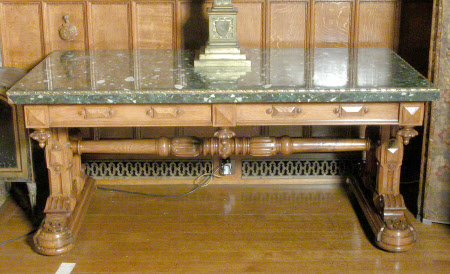Table
after Thomas Willement (London c.1786 - Faversham 1871)
Category
Furniture
Date
circa 1835
Materials
Carved oak, verde antico marble top with a gilt-bronze border
Place of origin
London
Order this imageCollection
Charlecote Park, Warwickshire
NT 532972
Summary
A pair of oak tables, circa 1835, the rectangular Verde Antico Roman top inset with a gilt bronze border, above a frieze with diamond carved cartouches and issuing inverted finials to each angle, on two trestle end supports joined by a tapering and turned high stretcher . The tops were bought in Rome by George Lucy (died in 1786) who received a letter dated "June 2nd 1758" from "Mr Russel" in Rome :"to inform (...) that your marble tables are completed and delivered; the brass rims are neatly finished". When quoting this letter in her Biography of the Lucy family (1862), Mary Elizabeth Lucy adds "These are the two fine Verd Antique slabs now in the billiard-room at Charlecote; they cost £80". The tables are thought to have been designed by Willement and made in London. According to C.Wainwright "they were the most innovatory pieces of furniture designed for the house". They can be paralleled with tables from Aston Hall created by Richard Bridgens and published in his book Furniture with candelabra (1825).
Provenance
The marble tops bought in Rome in 1758 by George Lucy (died in 1786). The table probably designed for Charlecote by Willement circa 1835. Presented to the National Trust by Sir Montgomerie Fairfax-Lucy (1896 – 1965), two years after the death of his father, Sir Henry Ramsay-Fairfax, 3rd Bt (1870 – 1944), with Charlecote Park and its chief contents, in 1946.
Makers and roles
after Thomas Willement (London c.1786 - Faversham 1871), designer
References
Wainwright, 1989: Clive Wainwright, The romantic interior: the British collector at home, 1750-1850. Studies in British Art. New Haven; London: Paul Mellon Centre for Studies in British Art by Yale University Press, 1989. [Charlecote pp.208-240]
